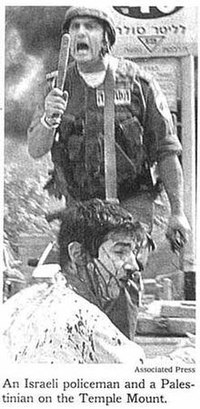|
Tuvia Grossman
 Tuvia Grossman (Hebrew: טוביה גרוסמן) is an Israeli-American man who was erroneously identified as a Palestinian in the caption of a photograph that was published by the Associated Press (AP) during the Second Intifada. Taken on the eve of Rosh Hashanah in September 2000, the photograph shows an officer of the Israel Border Police defending Grossman at a gas station after the latter was surrounded, stabbed, and beaten by a Palestinian mob when his taxi driver attempted to take a shortcut through a Palestinian neighbourhood in Jerusalem. However, the AP's caption identified Grossman as a Palestinian man at the Temple Mount, giving the impression that he had been brutalized by the Israeli police officer. It was marketed widely by the AP and featured in several Arab media and government outlets, in addition to mainstream American newspapers like The New York Times and The Wall Street Journal. Following the publishing, Grossman's father contacted The New York Times to correct his son's identity and reveal the true context of incident that was occurring when the photograph was taken. An article was then published by the newspaper to explain that Grossman was actually a Jewish student, that the photograph was not taken at the Temple Mount, and that the Israeli police officer—later identified as Gidon Tzefadi (Arabic: جدعون تزيفادي), a Druze from Kisra-Sumei—was ordering the attacking Palestinian mob to stay back. The AP publishing of Grossman's photograph highlights one of many contentious media incidents in the Israeli–Palestinian conflict. It received severe backlash from a number of pro-Israel watchdogs and advocacy organizations. Second Intifada incidentOn the eve of Rosh Hashana in September 2000, Grossman, a Jewish student from Chicago who was enrolled at Yeshivas Bais Yisroel in the Israeli settlement of Neve Yaakov (a neighborhood of Jerusalem), hailed a taxi with two friends to visit the Western Wall. When the driver took a shortcut through the East Jerusalem Palestinian neighborhood of Wadi al-Joz, a mob of about 40 Palestinian Arabs surrounded the taxi, smashed the windows, and dragged Grossman out, whereupon they beat him. The mob kicked him repeatedly, stabbed him once in the leg, and then pounded his head with rocks. Grossman managed to run to a nearby gas station where he collapsed, and an Israeli policeman, wielding a club, protected him and threatened the mob. The photograph was taken at that time by a freelance photographer who was at the gas station; in the photo, Grossman is shown bleeding and crouched under the policeman who is shouting and waving his club.[1] News coverageAt the outset of the Second Intifada on 30 September 2000, the New York Times and other media outlets published an AP photo of a bloodied Grossman crouching beneath a club-wielding Israeli Border Police officer. The caption under the photo simply identified the two as an "Israeli policeman and a Palestinian".[2] CorrectionsThe victim's true identity was revealed when Dr. Aaron Grossman of Chicago, the father of Tuvia Grossman, sent the following letter to the New York Times:[3][4][5]
In response, the New York Times published a correction on 4 October 2000, stating the following:[citation needed]
In this correction, Tuvia Grossman is accurately identified as "an American student in Israel," but it is not noted that he is Jewish and his beating is not described. The location is still misstated, this time as Jerusalem's Old City, while the true location was the Palestinian Arab neighborhood of Wadi al-Joz.[citation needed] Three days later, on 7 October 2000, the Times published another correction:[citation needed]
This note was accurate, and accompanied by an article which described the beating:[citation needed]
The article further noted the following:[6]
Usage in Arab media and government outletsSeveral organizations have used Grossman's picture, falsely presenting him as a Palestinian. One of them was an Egyptian government website, along with a number of other Arab sites.[2] This same picture has been used to cause anger toward Coca-Cola by falsely identifying Grossman as a Palestinian.[7] AftermathIn April 2002, a District Court in Paris ordered the French daily newspaper Libération and the Associated Press to pay 4,500 Euros to Grossman in damages for misrepresenting him.[citation needed] Seth Ackerman of FAIR, a progressive left-leaning media watchdog, posited that the response of pro-Israel media critics was excessive, as "no one alleged any deliberate falsification" by AP, adding that "the vast majority of injuries in Jerusalem the day the Grossman photograph was taken were sustained by Palestinians".[8] According to Ackerman, seven to eight U.S. newspapers picked up the photo along with the original erroneous caption. The Associated Press acknowledged the error and set about correcting it, along with almost all of the newspapers that printed the photograph. The New York Times published two retractions (one on 4 October 2000 and another three days later) as well as a 670-word news article tracing the incident from the time the photograph was taken to when it was published.[8]
Later lifeIn September 2005, Tuvia Grossman made aliyah (immigrated to Israel): "I knew that I wanted to be here, in Israel," Grossman said as he prepared to leave his hometown of Chicago for his flight. "Nothing was going to stop me." Grossman had studied law in his native Chicago. After immigrating to Israel, he did an internship at the Israeli Supreme Court,[9] passed the Israeli bar, and became a lawyer. Grossman worked for a time as an energy and infrastructure lawyer at both Gornitzky & Co. and Epstein Rosenblum Maoz (ERM) in Tel Aviv.[citation needed] Currently,[when?] he is the Director of Business Affairs at Tahal Water Energy Ltd.[citation needed] Identity of the police officerIn 2010, ten years after the incident, Tuvia Grossman finally met the police officer who saved his life, learning that his name was Gidon Tzefadi. Tzefadi is an Israeli Druze and former Chief Superintendent of the Israeli East Jerusalem Border Police. The event was documented on the website HonestReporting.[10] See alsoReferences
|
Portal di Ensiklopedia Dunia